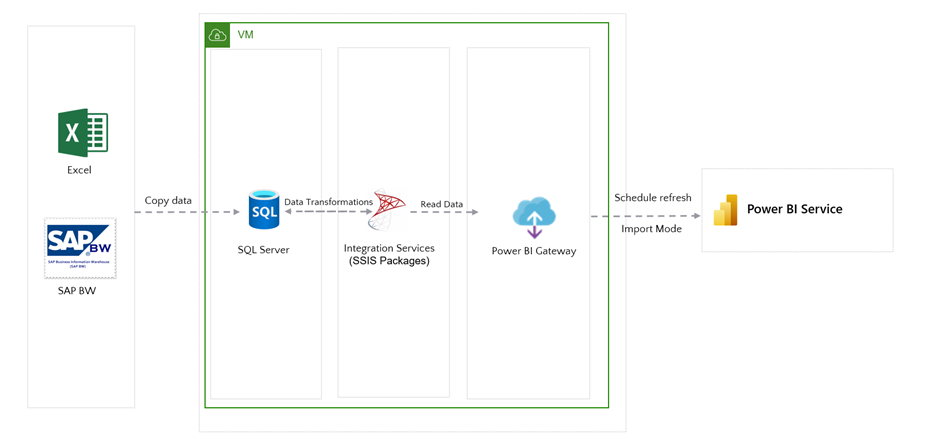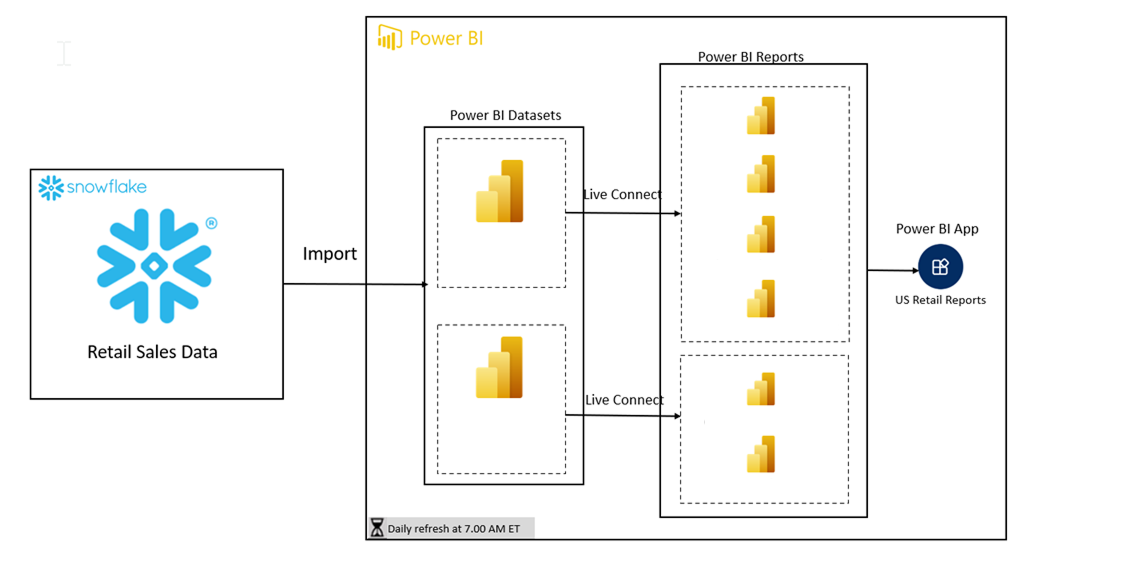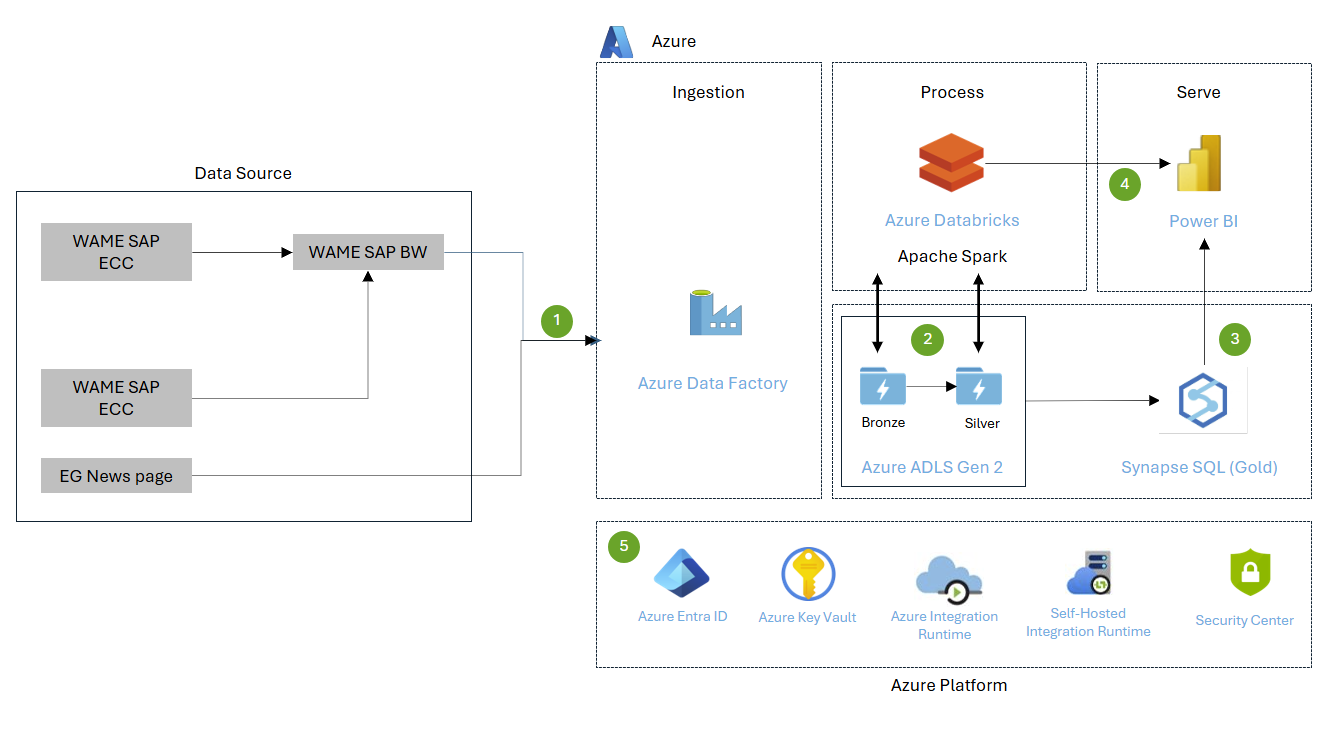Project overview
Our client, a global leader in supply chain logistics operating in over 60 countries, had been using Qlik as their enterprise reporting and data transformation platform for decades. With their Qlik license approaching expiration, they evaluated two options: Transitioning to Qlik Sense (web version) or migrating to Microsoft Power BI.
After a detailed assessment, the client selected Power BI due to its flexible licensing model, improved visual capabilities, and ability to reduce costs while maintaining high reporting standards. Their goals included:
1.
Reducing overall platform and licensing costs
2.
Improving backend data processing performance
3.
Maintaining legacy reporting capabilities and standards
Migration strategy
We initiated the migration with the client’s headquarters, which supports the Asia-Pacific (APAC) region. This region posed the greatest technical challenges due to high data volumes and complex reports. During this phase, we deprecated a low-usage, high-maintenance report to reduce unnecessary complexity.
Following the APAC deployment, we extended the migration to other regions, including North America and Europe. Each region had distinct needs:
·
North America required enhanced pre-production support for stability.
·
Canada received a full UI revamp to optimize reports for Power BI.
·
Europe and other regions underwent mostly as-is migrations, replicating Qlik reports with minimal layout changes.
Each region involved the migration of 10–12 reports, each ranging from 15 to 30 pages.
Architecture and data transformation
The primary focus of this project was migrating legacy Qlik reports to Power BI. All business logic and visuals were rebuilt using Power BI’s design framework, ensuring high performance and user familiarity.
Since Power BI is a reporting-only platform, we also migrated the underlying data transformations—previously handled within Qlik—into a centralized SQL database hosted on AWS. This on-premises SQL environment now supports all backend data processing, enabling faster refresh cycles and a more scalable architecture.

|
|
Figure 1: Solution architecture
|
Report customization and enhancement
To maintain Qlik functionality and provide a seamless user experience, we implemented several Power BI-specific customizations:
· Drill-through functionality: Replaced Qlik’s native drill-down capabilities, enabling users to navigate between summary and detailed views (e.g., navigating from summary to docket-level details).
·
Slicer optimization: Removed redundant and unused slicers while preserving essential ones to enhance report performance.
·
Conditional formatting: Replaced inflexible Qlik visuals with bar charts and custom formatting to highlight critical business indicators.
·
Layout and UX improvements: Introduced card visuals for KPIs, improved chart labeling, and reorganized dashboard layouts to match user expectations while improving clarity and consistency.
Change management
Since Qlik had been used for many years, end users were accustomed to specific visuals and workflows. To ensure high adoption, we performed a gradual transition in which we first replicated the visuals from Qlik, and then eventually provided a Power BI native version. We also provided year-long technical support upon completing the migration.
Business outcomes
· Complete migration: All legacy Qlik reports were successfully re-created and deployed in Power BI.
·
Cost savings: The client discontinued their Qlik license, reducing overall platform costs.
·
Performance gains: Faster backend data processing and improved dashboard responsiveness.
·
User satisfaction: Enhanced web-based UI and gradual onboarding drove high adoption and usability across global teams.
Ready to modernize your reporting platform?
MAQ Software provides end-to-end migration services from platforms including Qlik, Tableau, SAP BOBJ, MicroStrategy, and Cognos to Power BI.
Explore our app source offers:
Problem statement
A Fortune 500 office supply retailer had been relying on MicroStrategy reports for years. These reports were used by Sales, Finance, Accounting, and Human Resources team members to track sales performance across their U.S. retail stores.
However, the legacy reports were suboptimal in cost and functionality. In addition to requiring each report user to have a license, the platform forced users to create new versions of reports every time they needed to apply different filters. With their MicroStrategy licenses approaching expiration, the client sought a cost-effective reporting solution that would improve functionality and customization.
Business challenges
· License costs: MicroStrategy’s per-user licensing model was expensive, as every report viewer required a license.
·
Report duplication: Any time a user wanted to apply new filters to specific values in the reports, a new version had to be saved and published. This led to over 150 separate reports.
·
Engineering dependency: Backend logic had to be maintained by engineers instead of the reporting team.
Why migrate to Power BI?
· Cost savings: Power BI is included with Microsoft 365, removing the need for separate licenses for most users.
·
Report consolidation: Power BI’s filtering capabilities eliminate the need for publishing duplicate reports.
·
Enhanced features: Features such as advanced filtering, range sliders, and Microsoft Teams integration are built in.
Migration approach
With their backend data in Snowflake, our team evaluated both DirectQuery and Import Mode for integration. Due to performance limitations with DirectQuery, we adopted Import Mode. The semantic model was designed to load 70MB of data. For a rolling two-year period, data is collected at the product, customer account, and sales transaction level.
Recognizing the heavy reliance on legacy reports, we led a strategic change management approach to support the transition. We delivered a 4–6-month UX engagement involving all field users—from store managers to senior VPs.

|
|
Figure 1: Power BI reporting logic
|
Note: With Microsoft Fabric’s introduction of DirectLake, we are now evaluating this option for future optimization.
Key features delivered
· Bookmarks: Users can save filter configurations to revisit specific views without recreating filters.
·
Custom timeframes: Unlike MicroStrategy’s fixed intervals, Power BI allows users to define any date range for analysis.
·
Personalization: Reports allow users to select the dimensions and measures they want to view, as well as change visualization type.
·
Data dictionary: A training library in SharePoint with demo videos and documentation to help users understand each metric in the reports.
·
Export to Excel: Users can choose whether to export summarized visuals, current layout, or raw data by connecting directly to Snowflake.
Business outcome
We were able to consolidate their 150+ MicroStrategy reports into 5 core Power BI reports, each with around 10-20 user-defined bookmarks. After the migration, the client decommissioned their MicroStrategy licenses, significantly lowering costs. The reporting team now owns and manages reporting logic with reduced dependency on engineers.
Ready to migrate?
MAQ Software offers end-to-end migration services from MicroStrategy, Tableau, SAP BOBJ, Databricks, and other platforms.
Check out our Microsoft AppSource offerings:
Project overview
Our client, a global food and beverage conglomerate, required a large-scale data and reporting migration from SAP BusinessObjects (BOBJ) to Microsoft Power BI. The organization faced challenges with static reports and slow performance in BOBJ, prompting a strategic shift to Power BI—a more agile and integrated analytics platform that had already become the standard for most of their internal reporting initiatives.
For on-site product managers, a key daily activity involves reviewing the previous day’s sales performance to inform task assignment and operational planning. This requires fast, reliable access to detailed KPIs—including total sales, volume in kilograms, and volume in cases—presented in reports optimized for rapid decision-making.
Project scope
· Reports migrated: 120+
·
Data volume: 100 million+ rows
·
Data sources: Structured data from SAP and EG News page
·
Impacted business units: Sales and Go-to-Market (GTM) operations
Key challenges
1.
Large-scale migration complexity:
·
Migrating over 120 reports with more than 100 million rows of data posed a significant technical challenge. Each report had to be replicated in Power BI while maintaining the functionality, logic, and business rules of SAP BOBJ.
2.
Multiple data sources:
·
The project involved consolidating structured data from SAP and EG News page (a mobile-based field sales platform). These systems had different schemas and refresh cycles, demanding a robust data pipeline architecture to unify them under a consistent model.
3.
Data export limitations in Power BI :
·
SAP BOBJ supported detailed, cell-level exports of large tables—a feature not natively available in Power BI. To replicate this functionality, we implemented Power BI Paginated Reports, enabling high-volume data exports while maintaining the visual and functional expectations of SAP BOBJ.
4.
Performance optimization at scale:
·
Some reports initially suffered from slow performance due to complex models and inefficient queries. We tackled this by optimizing queries and data models, separating business logic into flat tables where appropriate, and leveraging Azure Synapse Analytics to improve efficiency.
Solution
The data pipeline consisted of five main stages:
· Ingestion: Extracted data from SAP ECC, SAP BW, and EG News page using Azure Data Factory (ADF)
·
Storage and Processing: Stored raw and cleaned data in Azure Data Lake Storage Gen2 and processes it using Apache Spark via Azure Databricks.
·
Serving: Refined datasets are stored in Synapse SQL (Azure Synapse Analytics) for fast querying.
·
Visualization: Dashboards and reports are integrated with Power BI service for interactive reporting, and Power BI Report Builder for paginated reports.
·
Supporting Services: Ensured security, access control, and execution with Azure Entra ID, Key Vault, Integration Runtimes, and Security Center.

|
|
Figure 1: Solution architecture
|
Outcomes
· Faster report load times: Product managers can now filter and view daily reports within seconds, improving agility and responsiveness in sales planning and task allocation.
·
Enhanced visual insights: The broader visualization capabilities of Power BI enabled users to analyze trends and patterns specific to their needs, facilitating better decision-making.
·
Mobile accessibility: Reports are now accessible through the Power BI mobile app, allowing secure access to insights from anywhere—without reliance on desktop environments.
·
Improved data refresh: With Azure Synapse pipelines supporting data refresh cycles, performance and reliability improved significantly compared to the old BEX query model under SAP BOBJ.
Looking ahead
After a successful migration of all key reports, the client was positioned to embrace a self-service analytics culture. This empowered product managers to make faster, more informed decisions based on timely, customized reports.
Interested in learning more?
Beyond SAP BusinessObjects, MAQ Software offers end-to-end migration services from platforms including Tableau, MicroStrategy, Cognos, and others.

Organizations today face a rapidly changing business landscape, where data is the key to staying competitive. As the demand for scalable, cost-effective solutions grows, many companies are making the shift from Tableau to Power BI. With AI-powered capabilities embedded in the Power BI workload within Microsoft Fabric, businesses can harness automation, self-service analytics, and advanced decision-making tools at a lower total cost of ownership.
The migration process from Tableau to Power BI can be overwhelming due to the complexities of planning, minimizing business disruptions, rebuilding reports and dashboards, adapting to a new interface, and managing costs—all while maintaining operational efficiency. MigrateFAST simplifies data and report migration through automation, reducing time-to-market and enabling a smooth transition with minimal disruptions.
6-step migration process with MigrateFAST

Transitioning from Tableau to Power BI can be smooth and efficient with the right approach. MigrateFAST’s highly automated process enables a seamless migration across six key stages, reducing costs and time-to-market.
1. Inventory Analysis: Laying the Foundation
Before the migration can take place, a complete inventory of Tableau workbooks, extracts, data models, and reports is essential to evaluate what needs to be migrated, what can be retired, and what may require re-engineering. Accurate and thorough inventory analysis ensures that you know exactly what you’re working with before diving into the migration process.
This step alone can take weeks without automation. MigrateFAST automatically analyzes Tableau data models and connections and accelerates the creation of metadata documents with a few clicks.
2. Estimation & Planning: Clarity from Day One
Successful migrations require a clear estimate of costs, risks, and unknowns. A well-laid-out plan can help prevent unexpected issues during migration and ensure that the project remains within scope and budget.
MigrateFAST automates the estimation of licensing costs, infrastructure requirements, and the creation of a detailed migration timeline. Using historical data and pre-built migration pathways, MigrateFAST reduces uncertainty, providing a clear and actionable plan for each phase of the migration.
3. Semantic Model & Report Creation: Delivering Consistent Insights
Recreating semantic models and reports is the most visible part of the process for end users. It is essential that reports in Power BI look and behave the same way as in Tableau, if not better. Reports should be optimized for Power BI’s interface and features. Moreover, identifying and removing redundant reports helps improve the efficiency of the migration and performance of Power BI reports after deployment.
MigrateFAST reduces manual efforts by:
· Migrating LOD expressions to DAX measures
· Automatically creating Power BI semantic models
· Recreating Tableau visualizations in Power BI
4. Review: Ensuring Data Accuracy and Integrity
Migrating large amounts of data and reports from one platform to another can lead to performance issues, incorrect data mappings, or errors in calculations. Without thorough review, there is a risk that your reports could deliver incorrect or suboptimal results.
MigrateFAST automates the validation of the migrated reports by running performance tests, optimizing queries, and ensuring data accuracy through validation and certification.
5. Governance: Maintaining Control and Integrity
Data governance is essential in migration to support data validation and certification processes while ensuring dataset integrity. A well-defined governance framework provides proactive alerts and real-time monitoring of capacity, usage, report availability, and platform issues.
Our approach automates performance optimization to ensure adherence to best practices and pre-defined SLAs.
6. Center of Excellence (CoE): Supporting Long-Term Success
Migration doesn’t end once the reports are deployed. Post-migration support is essential for monitoring system performance, optimizing costs, and ensuring that the organization can effectively adopt and use the new platform.
We provide ongoing support to optimize costs, monitor system performance, and improve change management. This approach drives higher adoption and long-term success—helping your organization move from reactive fixes to proactive innovation.
Customer success story
A leading retail client with 25,000+ users needed a scalable, secure, and resilient centralized data platform. Their existing infrastructure included 300+ workbooks, 350+ extracts, and a 200 TB Teradata database, supporting 200+ concurrent users. After migrating from Tableau to Power BI, the client achieved:
• 60% reduction in overall maintenance and new development effort
• 35% cost savings on platform and maintenance
• NSAT score improvement from 2 to 3.5
• 300% increase in adoption within a year through CoE setup
With MigrateFAST, the client’s migration effort was automated by approximately 60%, dramatically reducing manual intervention and shortening the migration timeline.
| Migration Steps |
Automated using toolkit |
Efforts without MigrateFAST (in hrs.) |
Efforts with MigrateFAST (in hrs.) |
| Analyze Tableau data model and connections |
✓ |
10 |
0 |
| Create metadata document |
✓ |
5 |
0 |
| Create Power BI Semantic model |
✓ |
16 |
0 |
| Understand calculations and recreate them in DAX |
✓ |
24 |
0 |
| Validate and fix calculated columns and measure definitions |
✗ |
16 |
20 |
| Understand and create field parameters |
✓ |
8 |
4 |
| Create Power BI reports with base measures |
✓ |
16 |
4 |
| Implement field parameters in the report |
✓ |
4 |
2 |
| Identify alternate visuals for gaps |
✗ |
4 |
4 |
| Optimize performance (CertyFAST) |
✓ |
8 |
4 |
| Data validation |
✗ |
8 |
8 |
| Total |
|
119 (~25 days) |
46 (~6 days) |
Figure 1: Migration effort with MigrateFAST per workbook
MigrateFAST ensures a seamless transition to Power BI, preserving Tableau’s look and feel while enhancing usability with AI-powered capabilities.

Figure 2: User interface of Tableau vs. Power BI
Expanding MigrateFAST Capabilities
Beyond Tableau, MigrateFAST streamlines migration from multiple platforms, including MicroStrategy, Cognos, SAP BOBJ, and more. Our customized approach aligns with your data architecture requirements, ensuring a seamless transition to help you harness Power BI’s full capabilities.
In a rapidly evolving market, Independent Software Vendors (ISVs) must
integrate innovative solutions to remain competitive. AI-driven features and
self-service solutions have become critical business requirements. To address
these challenges, ISVs can implement a Custom Copilot with Power BI Embedded
to significantly enhance user engagement and operational efficiency, driving
future business growth.
The issue
A leading information services provider sought to enhance data analytics
capabilities within its products. The goal was to decrease the number of
support tickets, minimize reliance on custom dashboards, and strengthen the
products’ market position.
The solution
A Custom Copilot agent was designed to enable self-service capabilities
by streamlining the extraction of actionable insights from Power BI
reports. The solution contained the following components:
· AI: The solution used Azure OpenAI to create the
chatbot and to respond to users.
·
Databases (DB): The solution used Azure SQL DB to
store and manage feedback on the bot usage.
·
Applications (Apps): Azure WebApp served as the
primary application to host the chatbot.
Our accelerators helped the client achieve faster time-to-market by
building the solution quickly and efficiently. We implemented the solution
in alignment with the Azure Well-Architected Review Framework, ensuring
optimal performance, security, reliability, cost-efficiency, and
operational excellence.
Solution flow
User authentication
· Users log in securely with their credentials.
· Access permissions are validated to ensure the right level of data access.
Interactive chat interface
· Users enter queries in natural language.
· The bot processes the query using AI and NLP to understand intent.
Power BI data retrieval
· The bot retrieves relevant data from Power BI reports.
· Text-based insights are generated alongside visual elements (charts, graphs, tables).
Visual insights generation
· The bot extracts and displays dynamic visual insights such as charts, graphs, and tables from Power BI for better clarity.
User interaction and feedback loop
· Users engage with insights and provide feedback via like/dislike buttons or additional comments.
· The bot learns from feedback to improve the relevance and accuracy of future responses.
Security and compliance
· The bot adheres to CoreLogic and Microsoft security standards, ensuring data protection.
· Role-based access control and data encryption are enforced for compliance and privacy.

|
|
Figure 1: Solution architecture
|
Business impact
The implementation yielded significant improvements in key operational areas:
· Self-service access: Enabled users to access and interpret data without technical expertise.
·
Quick decision-making: Real-time insights allowed users to proactively respond to market shifts and business challenges.
·
Enhanced user engagement: The interactive chat and visuals improved user experience and adoption.
·
Operational efficiency: Optimized workflows by automating data exploration and reducing manual effort.
Summary
By implementing the Custom Copilot agent with Power BI Embedded, the ISV met critical business requirements, from self-service analytics to enhanced decision-making. This strengthened the company’s competitive position by improving user engagement, optimizing productivity, and achieving faster time-to-market.
Interested in learning more?
When it comes to adopting AI and analytics solutions, you need a trusted partner to help deliver impactful results. Contact
CustomerSuccess@MAQSoftware.com to explore how MAQ Software can help you achieve your business goals.











